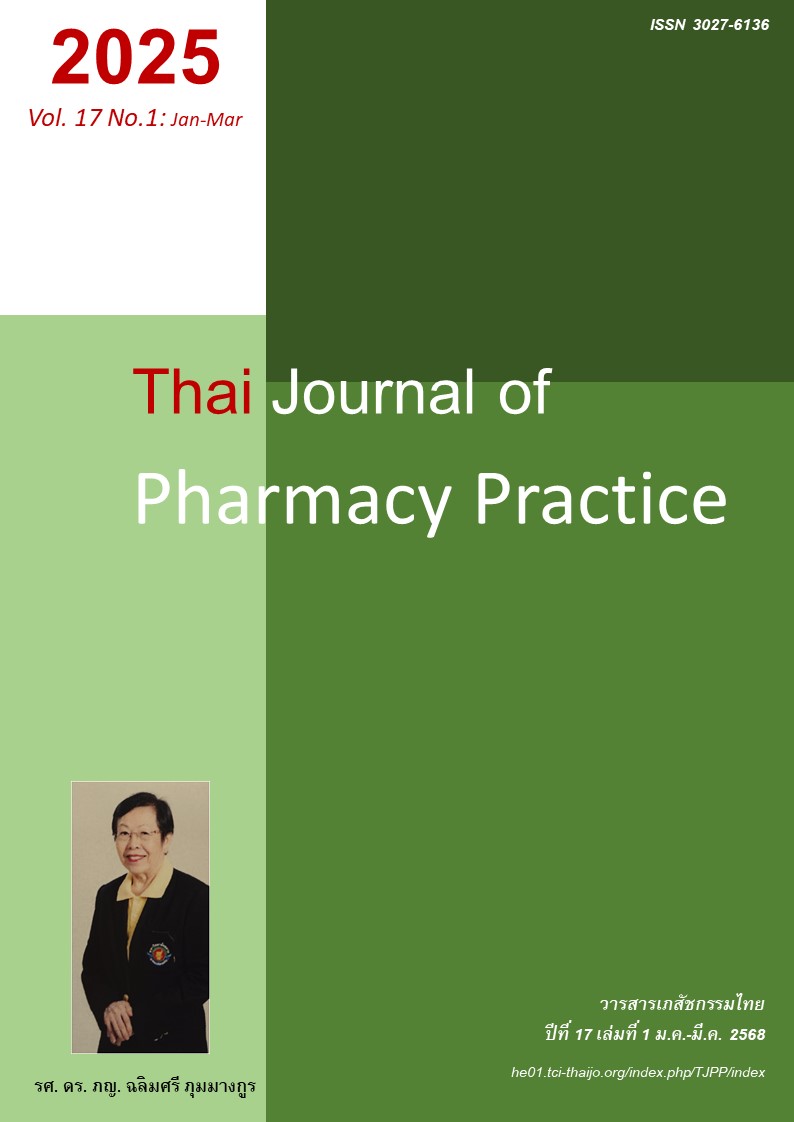คุณภาพชีวิตด้านการใช้ยาของนักศึกษามหาวิทยาลัยที่ได้รับยาต้านเศร้า
Main Article Content
บทคัดย่อ
วัตถุประสงค์: เพื่อประเมินคุณภาพชีวิตด้านการใช้ยาในนักศึกษามหาวิทยาลัยที่ได้รับยาต้านเศร้า วิธีการ: การวิจัยเชิงพรรณนาแบบตัดขวาง รวบรวมข้อมูลจากกลุ่มตัวอย่างคือ นักศึกษาทุกระดับชั้น จำนวน 76 คนที่ได้รับยาต้านเศร้า ณ ฝ่ายส่งเสริมสุขภาวะจุฬาลงกรณ์มหาวิทยาลัย ระหว่างเดือนมีนาคม-มิถุนายน พ.ศ. 2566 การประเมินคุณภาพชีวิตด้านการใช้ยาใช้แบบสอบถาม Patient-Reported Outcomes Measure of Pharmaceutical Therapy (PROMPT) ฉบับย่อ ผลการวิจัย: กลุ่มตัวอย่างมีอายุเฉลี่ย 21.33 ± 2.94 ปี คุณภาพชีวิตด้านการใช้ยาของกลุ่มตัวอย่างทั้ง 8 มิติ (16 ข้อคำถาม) อยู่ในระดับปานกลางถึงดี (มีค่าคะแนนอยู่ในช่วงคะแนน 51-75 คะแนนจากคะแนนเต็ม 100 คะแนน) โดยแต่ละมิติมีค่าเฉลี่ยคะแนน ดังนี้ มิติที่ 1 การได้รับ ข้อมูลยาและโรคมีคะแนนเฉลี่ย 59.08 ± 18.61 คะแนน; มิติที่ 2 ความพึงพอใจเกี่ยวกับประสิทธิผลของยามีคะแนนเฉลี่ย 59.87 ± 20.65 คะแนน; มิติที่ 3 ผลกระทบจากอาการข้างเคียงของยามีคะแนนเฉลี่ย 55.59 ± 26.33 คะแนน; มิติที่ 4 ผลทางด้านจิตใจของการใช้ยามีคะแนนเฉลี่ย 60.20 ± 23.16 คะแนน; มิติที่ 5 ความสะดวกในการใช้ยาคะแนนเฉลี่ย 68.75 ± 27.12 คะแนน; มิติที่ 6 การมียาให้ใช้และเข้าถึงการใช้ยามีคะแนนเฉลี่ย 70.39 ± 29.92 คะแนน; มิติที่ 7 ความสัมพันธ์ทางด้านการรักษามีคะแนนเฉลี่ย 70.39 ± 27.00 คะแนนและมิติที่ 8 คุณภาพชีวิตโดยรวมมีคะแนนเฉลี่ย 59.54 ± 22.35 คะแนน สรุป: ผลการวิจัยทำให้ทราบถึงคุณภาพชีวิตด้านการใช้ยาในแต่ละมิติของนักศึกษามหาวิทยาลัยที่ได้รับยาต้านเศร้าเพื่อใช้เป็นข้อมูลในการติดตามการรักษาและใช้ในการพัฒนาแนวทางของการบริบาลทางเภสัชกรรมต่อไป
Article Details

อนุญาตภายใต้เงื่อนไข Creative Commons Attribution-NonCommercial-NoDerivatives 4.0 International License.
ผลการวิจัยและความคิดเห็นที่ปรากฏในบทความถือเป็นความคิดเห็นและอยู่ในความรับผิดชอบของผู้นิพนธ์ มิใช่ความเห็นหรือความรับผิดชอบของกองบรรณาธิการ หรือคณะเภสัชศาสตร์ มหาวิทยาลัยสงขลานครินทร์ ทั้งนี้ไม่รวมความผิดพลาดอันเกิดจากการพิมพ์ บทความที่ได้รับการเผยแพร่โดยวารสารเภสัชกรรมไทยถือเป็นสิทธิ์ของวารสารฯ
เอกสารอ้างอิง
Shorey S, Ng ED, Wong CHJ. Global prevalence of depression and elevated depressive symptoms among adolescents: A systematic review and meta-analysis. Br J Clin Psychol. 2022; 61: 287-305.
Thapar A, Collishaw S, Pine DS, Thapar AK. Depression in adolescence. Lancet. 2012; 379: 1056-67.
Maughan B, Collishaw S, Stringaris A. Depression in childhood and adolescence. J Can Acad Child Adolesc Psychiatry 2013; 22: 35-40.
Weersing VR, Shamseddeen W, Garber J, Hollon SD, Clarke GN, Beardslee WR, et al. Prevention of depression in at-risk adolescents: predictors and moderators of acute effects. J Am Acad Child Adolesc Psychiatry 2016; 55: 219-26.
DeFilippis M, Wagner KD. Management of treatment-resistant depression in children and adolescents. Paediatr Drugs 2014; 16: 353-61.
Sabella D. Antidepressant medications. Am J Nurs 2018; 118: 52-9.
Cipriani A, Zhou X, Del Giovane C, Hetrick SE, Qin B, Whittington C, et al. Comparative efficacy and tolerability of antidepressants for major depressive disorder in children and adolescents: a network meta-analysis. Lancet. 2016; 388: 881-90.
Jane Garland E, Kutcher S, Virani A, Elbe D. Update on the use of SSRIs and SNRIs with children and adolescents in clinical practice. J Can Acad Child Adolesc Psychiatry 2016; 25: 4-10.
Hazell P, Mirzaie M. Tricyclic drugs for depression in children and adolescents. Cochrane Database Syst Rev. 2013; 2013: CD002317. doi: 10.1002/14651858 .CD002317.pub2.
Locher C, Koechlin H, Zion SR, Werner C, Pine DS, Kirsch I, et al. Efficacy and safety of selective serotonin reuptake inhibitors, serotonin-norepine- phrine reuptake inhibitors, and placebo for common psychiatric disorders among children and adolescents: A systematic review and meta-analysis. JAMA Psychiatry. 2017; 74: 1011-20.
Cochran W. Sampling techniques. 3 rd ed. New York: John Wiley & Sons; 1977.
Sakthong P, Chinthammit C, Sukarnjanaset P, Sonsa-Ardjit N, Munpan W. Psychometric properties of the Patient-Reported Outcomes Measure of Pharmaceutical Therapy for Quality of Life (PROMPT-QOL). Value Health Reg Issues. 2017; 12: 41-9.
Sakthong P, Suksanga P, Sakulbumrungsil R, Winit-Watjana W. Development of Patient-reported Outcomes Measure of Pharmaceutical Therapy for Quality of Life (PROMPT-QoL): A novel instrument for medication management. Res Social Adm Pharm. 2015; 11: 315-38.
Sakthong P, Sonsa-Ardjit N, Sukarnjanaset P, Munpan W, Sangthonganotai T. Development and psychometrics of a short-form pharmaceutical care-specific measure for quality of life. Int J Clin Pharm. 2018; 40: 642-9.
Mishra A, Krishna GS, Alla S, Kurian TD, Kurian J, Ramesh M, et al. Impact of pharmacist-psychiatrist collaborative patient education on medication adherence and quality of life (QOL) of bipolar affective disorder (BPAD) patients. Front Pharmacol. 2017; 8: 722.
Parihar A, Ganachari MS, Tekkalaki B, Shashikala W. The impact of clinical pharmacist lead collaborative care on quality of life of the patients with bipolar disorder: A unicenter prospective, randomiza- tion study. Indian Journal of Pharmaceutical Education and Research. 2017; 51: s129-35.
Sell R, Schaefer M. Prevalence and risk factors of drug-related problems identified in pharmacy-based medication reviews. Int J Clin Pharm 2020; 42: 588-97.


